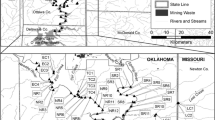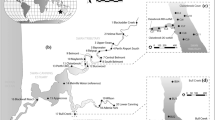Abstract
The Screening Level Concentration (SLC) approach was used to derive Lowest Effect Level (LEL) and Severe Effect Level (SEL) concentrations for nine metals (As, Cr, Cu, Pb, Mo, Ni, Se, U and V) and three radionuclides (226Ra, 210Pb, and 210Po) released to the aquatic environment during the mining and milling of uranium ore. This method was chosen because it allowed for the best use of the considerable historical and current data collected for diverse purposes in the uranium mining and milling regions of Canada (20,606 data points used in the analysis). Except for Cr, all the LELs derived in this study using the weighted method and published sediment quality guidelines (SQGs) were highly reliable (> 85%) in predicting sites unimpacted by uranium mining/milling defined as sites where reductions in the abundance and species richness of benthic invertebrate communities were < 20%. The derived SEL values and corresponding published SQGs (with the exception of Ni) were not reliable predictors (≤60%) of severe impacts on benthic invertebrate communities when severe impacts are defined as a reduction in abundance and species richness ≥40%. Most of the severely impacted sites had sediment contaminant concentrations well below the SEL values. It is concluded that LELs derived using the weighted method can reliably be used in ecological risk assessments as concentrations below which adverse effects on benthic invertebrate communities are not expected. In contrast, it is recommended that SELs not be used in assessments of uranium mining/milling activities as concentrations above which adverse effects are anticipated.
Similar content being viewed by others
References
BEAK International Inc.: 1998, Toxicity of Uranium and Trace Metals Discharged to the Aquatic Environment, Project No. 12020.1, Atomic Energy Control Board, Ottawa, Canada.
Borgmann, U., Neron, R. and Norwood, W. P.: 2001, ‘Quantification of bioavailable nickel in sediments and toxic thresholds to Hyalella azteca’, Environ. Pollut. 11, 189–198.
Canadian Council of Ministers of the Environment: 1995, ‘Protocol for the Derivation of Canadian Sediment Quality Guidelines for the Protection of Aquatic Life’, Prepared by the Technical Secretariat of the CCME Task Group on Water Quality Guidelines, Ottawa, Canada.
Canadian Council of Ministers of the Environment: 1999, ‘Canadian Environmental Quality Guidelines’, Prepared by the Technical Secretariat of the CCME Task Group on Water Quality Guidelines, Ottawa, Canada.
Domotor, S. L., Wallo, A., III, Peterson, H. T., Jr. and Higley, K. A.: 2003, ‘The U.S. Department of Energy's Graded Approach for Evaluating Radiation Doses to Aquatic and Terrestrial Biota’, in: IAEA, 2003, Proceedings of the Third International Symposium on the Protection of the Environment from Ionising Radiation (SPEIR 3), 22–26 July 2002, Darwin, Australia.
Dunn, C. E.: 1980, Lake Sediment and Water Geochemistry of the Carswell Structure, Northern Saskatchewan. Report 224, Saskatchewan Ministry of Mineral Resources.
Environment Canada and Ministère de l'Environnement du Québec: 1992, ‘Interim Criteria for Quality Assessment of St. Lawrence River Sediment’, Environment Canada, Ottawa, Canada.
Fairey, R., Long, E. R., Roberts, C. A., Anderson, B. S., Phillips, B. M., Hunt, J. W., Puckett, H. R. and Wilson, C. J.: 2001, ‘An evaluation of methods for calculating mean sediment quality guideline quotients as indicators of contamination and acute toxicity to amphipods by chemical mixtures’, Environ. Toxicol. Chem. 20, 2276–2286.
International Atomic Energy Agency: 1992, ‘Effects of ionizing radiation on plants and animals at levels implied by current radiation protection standards’, Technical Report Series 332.
Jones, D. S., Barnthouse, L. W., Suter, G. W., II, and Efroymson, R. A.: 1999, ‘Ecological risk assessment in a large river-reservoir: 3. Benthic invertebrates’, Environ. Toxicol. Chem. 18, 599–609.
Liber, K. and Sobey, S.: 2000, ‘Toxicity of Uranium, Nickel, and Arsenic to Hyalella azteca in Spiked-Sediment Toxicity Tests’, in: Proceedings of the 27th Annual Aquatic Toxicity Workshop, 1–4 October 2000, St. John's New Foundland, Canada.
MacDonald, D. D., Ingersoll, C. G. and Berger, T. A.: 2000, ‘Development and evaluation of consensus-based sediment quality guidelines for freshwater ecosystems’, Arch. Environ. Contamin. Toxicol. 39, 20–31.
Merrit, R. W. and Cummins, K. W.: 1996, An Introduction to the Aquatic Insects of North America, 3rd edn., Kendall/Hunt Publishing Company, Iowa.
Milani, D., Reynoldson, T. B., Borgmann, U. and Kolasa, J.: 2003, ‘The relative sensitivity of four benthic invertebrates to metals in spiked-sediment exposures and application to contaminated field sediment’, Environ. Toxicol. Chem. 22, 845–854.
National Water Quality Management Strategy: 2000, ‘Australian and New Zealand Guidelines for Fresh and Marine Water Quality'. Prepared under the auspices of Australia and New Zealand Environmental and Conservation Council and Agriculture and Resource Management Council of Australia and New Zealand. Draft issued for Public Comment.
Neff, J. M., Bean, D. J., Cornaby, B. W., Vaga, R. M., Gulbransen, T. C. and Scanlon, J. A.: 1986, Sediment Quality Criteria Methodology Validation: Calculation of Screening Level Concentrations from Field Data. Batelle Washington Environmental Program Office. For U.S. EPA.
Pennak, R. W.: 1978, Freshwater Invertebrates of the United States, 2nd edn., Wiley, New York.
Persaud, D., Jaagumagi, R. and Hayton, A.: 1992, ‘Guidelines for the Protection and Management of Aquatic Sediment Quality in Ontario’. Prepared for the Ontario Ministry of the Environment.
United Nations Scientific Committee on the Effects of Atomic Radiation: 1996, ‘Effects of Radiation on the Environment’, A/AC 82/R.549, UNSCEAR, United Nations, Vienna, Austria.
United States Department of Energy: 2002, ‘A Graded Approach for Evaluating Radiation Doses to Aquatic and Terrestrial Biota’, DOE-STD-1153-2002, Final Technical Standard, July 2002.
Von Stackelberg, K. and Menzie, C. A.: 2002, ‘A cautionary note on the use of species presence and absence data in deriving sediment criteria’, Environ. Toxicol. Chem. 21, 466–472.
Author information
Authors and Affiliations
Corresponding author
Rights and permissions
About this article
Cite this article
Thompson, P.A., Kurias, J. & Mihok, S. Derivation and Use of Sediment Quality Guidelines for Ecological Risk Assessment of Metals and Radionuclides Released to the Environment from Uranium Mining and Milling Activities in Canada. Environ Monit Assess 110, 71–85 (2005). https://doi.org/10.1007/s10661-005-6291-0
Received:
Accepted:
Issue Date:
DOI: https://doi.org/10.1007/s10661-005-6291-0




